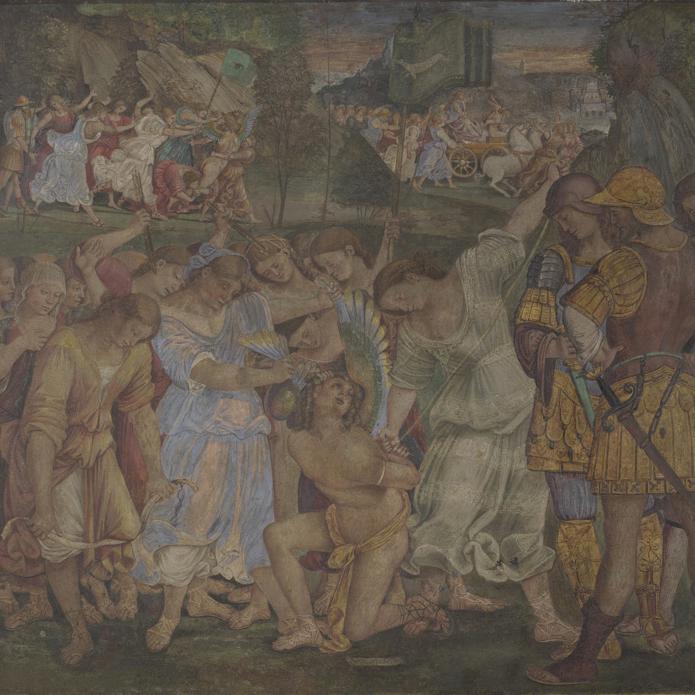Luca Signorelli, 'Coriolanus persuaded by his Family to spare Rome', about 1509
About the work
Overview
This picture, painted in fresco (directly onto wet plaster), was part of a series of eight which decorated the walls of the palace belonging to Pandolfo Petrucci, the ruler of Siena. He commissioned the frescoes to celebrate the marriage of his son to Pope Pius III’s niece. Two others survive in the National Gallery’s collection.
Coriolanus, a high-ranking Roman general, was banished from Rome in 491 BC, taking refuge with the neighbouring Volsci. Some years later he led them to victory against Rome. His mother Volumnia and his wife Vergilia – holding their baby – are here shown leading a deputation of women to beg for his mercy and to spare the city. Coriolanus, overwhelmed by emotion, opens his arms ready to embrace his elder child. Eventually he withdrew his troops, choosing family over politics.
The patron, Pandolfo Petrucci, may have identified with such a scene: he was banished from Siena briefly in the 1490s and went into self-imposed exile in 1503.
Key facts
Details
- Full title
- Coriolanus persuaded by his Family to spare Rome
- Artist
- Luca Signorelli
- Artist dates
- About 1440/50 - 1523
- Part of the series
- Three Frescoes from Palazzo del Magnifico, Siena
- Date made
- About 1509
- Medium and support
- Fresco, transferred to canvas
- Dimensions
- 125.7 × 125.7 cm
- Inscription summary
- Signed
- Acquisition credit
- Mond Bequest, 1924
- Inventory number
- NG3929
- Location
- Room 61
- Collection
- Main Collection
- Previous owners
- Frame
- 20th-century Replica Frame
Provenance
Additional information
Text extracted from the ‘Provenance’ section of the catalogue entry in Martin Davies, ‘National Gallery Catalogues: The Earlier Italian Schools’, London 1986; for further information, see the full catalogue entry.
Bibliography
-
1770Siena, Biblioteca Comunale, MS. C vii 20: G. Girolamo Carli, Notizie di Belle Arti, 1770
-
1786G. Della Valle, Lettere senesi… sopra le belle arti, Rome 1786
-
1791G. Vasari, Vite de' più eccellenti pittori scultori e architetti, ed. G. Della Valle, 11 vols, Siena 1791
-
1850G.F. Waagen, Ueber Leben, Wirken und Werke der Maler Andrea Mantegna und Luca Signorelli, n.p. 1850
-
1857G.F. Waagen, Treasures of Art in Great Britain: Being and Account of the Chief Collections of Paintings, Drawings, Sculptures, Illuminated Mss. […], translated from German by Elizabeth Eastlake, 3 vols, London 1857, vol. 3
-
1874J.W.C. Carr, 'The National Gallery', Art Journal, 1874, pp. 257ff
-
1874Christie, Manson & Woods, Catalogue of the Renowned Collection of Works of Art, Formed by that Distinguished Connoisseur, Alexander Barker, Esq., London, 6 June 1874 - 11 June 1874
-
1879R. Vischer, Luca Signorelli und die italienische Renaissance: Eine kunsthistorische Monographie, Leipzig 1879
-
1893Burlington Fine Arts Club, The Work of Luca Signorelli and His School, London 1893
-
1903J.A. Crowe and G.B. Cavalcaselle, A History of Painting in Italy, Umbria, Florence and Siena, from the Second to the Sixteenth Century, ed. R.L. Douglas, 2nd edn, 6 vols, London 1903
-
1903G. Mancini, Vita di Luca Signorelli, Florence 1903
-
1923R. van Marle, The Development of the Italian Schools of Painting, 19 vols, The Hague 1923
-
1927L. Düssler, Signorelli, Klassiker der Kunst 34, Berlin 1927
-
1937P. Verlet, 'A Faenza Panel at the Victoria and Albert Museum', The Burlington Magazine, LXXI/415, 1937, pp. 183-4
-
1951Davies, Martin, National Gallery Catalogues: The Earlier Italian Schools, London 1951
-
1956M. Salmi, Luca Signorelli, Novara 1956
-
1960E. Carli, Il Pintoricchio, Milan 1960
-
1961M. Davies, The Earlier Italian Schools, 2nd edn, London 1961
-
1967M. Salmi, Il Palazzo e la collezione Chigi-Saracini, Siena: Monte dei Paschi di Siena 1967
-
1968A.P. Tofani, 'Una predella giovanile di Girolamo Genga', in Festschrift Ulrich Middledorf, Berlin 1968, pp. 206-12
-
1969A.P. Tofani, 'Per Girolamo Genga', Paragone, CCXXIX, 1969, pp. 18-36
-
1969P. Venturoli, 'Amico Aspertini a Gradara', Storia dell'arte, 4, 1969, pp. 417-32
-
1978P. Torriti, La Pinacoteca Nazionale di Siena i dipinti dal XV al XVIII secolo, Genoa 1978
-
1978V. Tátrai, 'Gli affreschi del Palazzo Petrucci a Siena: Una precisazione iconografica e un ipotesi sul programma', Acta historiae artium, XXIV/1-4, 1978, pp. 177-83
-
1981A. Conti, 'Vicende e cultura del restauro', in P. Fossati (ed.), Storia dell'Arte Italiana, Turin 1981, vol. 10, pp. 39-112
-
1982G. Agosti, 'Precisioni su un "Baccanale" perduto del Signorelli', Prospettiva, XXX, 1982, pp. 70-7
-
1982F. Sricchia Santoro, 'Ricerche senesi, 2: Il Palazzo del Magnifico Pandolfo Petrucci', Prospettiva, 29, 1982, pp. 24-31
-
1983A. Petrioli Tofani, Urbino e le Marche prima e dopo Raffaello (exh. cat. Palazzo Ducale e Chiesa di San Domenico, 30 July - 30 October 1983), Urbino 1983
-
1985A. Ferrari, R. Valentini and M. Vivi, 'Il Palazzo del Magnifico a Siena', Bollettino senese di storia patria, XCII, 1985, pp. 105-55
-
1986Davies, Martin, National Gallery Catalogues: The Earlier Italian Schools, revised edn, London 1986
-
1989L. Kanter, The Late Works of Luca Signorelli and His Followers, 1498-1559, Phd Thesis, New York University 1989
-
1990F.S. Santoro and G. Agosti, Domenico Beccafumi e il suo tempo, (exh. cat. Pinacoteca Nazionale di Siena, Palazzo Bindi Sergardi, 16 June - 4 November 1990), Milan 1990
-
1991J. Dunkerton et al., Giotto to Dürer: Early Renaissance Painting in the National Gallery, New Haven 1991
-
1997G.C. Dini, A. Angelini and B. Sani, Pittura senese, Milan 1997
-
1998T. Henry, Signorelli in British Collections (exh. cat. The National Gallery, 11 November 1998 - 31 January 1999), London 1998
-
1999M. Baxandall, Die Wirklichkeit der Bilder: Malerei und Erfahrung im Italien der Renaissance, Berlin 1999
-
2001
C. Baker and T. Henry, The National Gallery: Complete Illustrated Catalogue, London 2001
-
2002T. Henry and L. Kanter, Luca Signorelli: The Complete Paintings, New York 2002
-
2002A.W.B. Randolph, Engaging Symbols: Gender, Politics, and Public Art in Fifteenth-Century Florence, New Haven 2002
-
2003M. Caciorgna and R. Guerrini, La virtù figurata: Eroi ed eroine dell'antichità classica nell'arte senese tra Medioevo e Rinascimento, Siena: Fondazione Monte dei Paschi di Siena 2003
-
2004P. Scarpellini and M.R. Silvestrelli, Pintoricchio, Milan 2004
-
2005A. Angelini, Pio II e le arti: La riscoperta dell'antico da Federighi a Michelangelo, Siena 2005
-
2006M. Caciorgna, 'Radice atra, purpureus flos: Ulisse, Mercurio e l'erba moly nello Stanzino di Francesco I de'Medici. Fonti letterarie e tradizione iconografica', in P. Morel, F. Alberti and V. Schmitts (eds), L'art de la Renaissance entre science et magie, Paris 2006, pp. 269-94
-
2007F.F. Mancini, Pintoricchio, Milan 2007
-
2007L. Syson et al., Renaissance Siena: Art for a City (exh. cat. The National Gallery, 24 October 2007 - 13 January 2008), London 2007
-
2008V. Garibaldi and F.F. Mancini, Pintoricchio, (exh. cat. Galleria nazionale dell'Umbria, 2 February - 29 June 2008), Milan 2008
About this record
If you know more about this work or have spotted an error, please contact us. Please note that exhibition histories are listed from 2009 onwards. Bibliographies may not be complete; more comprehensive information is available in the National Gallery Library.
Images
About the series: Three Frescoes from Palazzo del Magnifico, Siena

Overview
These three paintings in fresco (painted directly on to wet plaster) once decorated the walls of a room in the Petrucci family palace in Siena. Each wall was painted with two frescoes, positioned on either side of a doorway or window. The ceiling, which can be seen at the Metropolitan Museum of Art, New York, contained 20 frescoes of mythological scenes, divided by carved, painted and gilded stucco (plaster), produced by Pintoricchio and his workshop. At the centre was the Petrucci coat of arms, surrounded by flying putti (cherubs).
The frescoes were commissioned by Pandolfo Petrucci to celebrate the marriage of his son to the niece of Pope Pius III. The occasion provided an opportunity to show off his fashionable interest in classical history – through scenes from ancient Greek and Roman literature and history, the frescoes illustrate family values and the virtues important to marriage.










